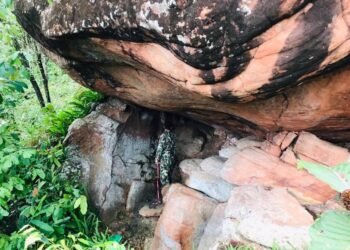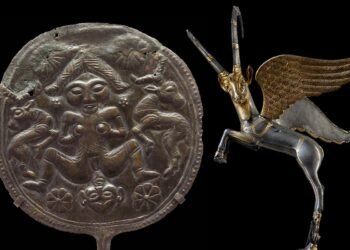Archaeologists have uncovered a stunning Roman-era stele in the city of Manbij, east of Aleppo in northern Syria. The stone, carved out of heavy black basalt, bears an eagle spreading its wings and clutching a wreath in its talons, along with a Greek inscription. Experts theorize that the 2,000-year-old piece might have served as a funerary marker in Roman times.
The discovery was first made when a local resident discovered the stone near the Cardamom wholesale market. He reported it to the Directorate of Museums and Antiquities, which sent an expeditionary team to recover the artifact. Locally, meanwhile, the stele is guarded in anticipation of its transfer to Aleppo for further studies.
The discovery highlights Manbij’s ancient heritage and the ongoing threat to Syria’s cultural patrimony. Known in ancient times as Hierapolis, or “Sacred City,” Manbij was previously a significant Aramaic and Assyrian city before flourishing under the Seleucid dynasty following Alexander the Great’s conquests. It later became renowned for its cult of Atargatis, the Syrian fertility goddess whose temple complex attracted pilgrims from all over the region. Lucian of Samosata, a Syrian-born 2nd-century CE essayist, described the city’s ceremonies in his treatise De Dea Syria, written in Ionic Greek. Hierapolis remained a thriving spiritual and commercial hub even under Roman rule.
But the splendor of ancient Manbij eventually gave way to decline, and in more recent times, the devastation of the Syrian civil war. The Directorate-General of Antiquities and Museums estimates the number of artifacts looted between 2011 and 2019 at up to one million, and more than 700 sites in the country have been critically damaged.
Manbij itself became a focal point for antiquities smuggling. Treasure hunting under the Assad regime was tightly controlled by well-connected elites. When the city was captured by the Free Syrian Army in 2012, control disintegrated and looting expanded on a massive scale. This was followed by ISIS’s capture of the city in 2014, when the group implemented a licensing system for digging: locals could dig with licenses, but rare discoveries were taxed, and artifacts with figural imagery were confiscated and occasionally destroyed.
Since the capture of the city by the Syrian Democratic Forces (SDF) in 2016, the antiquities trade has continued under changed conditions. Local leaders and associates managed excavations, demanded cuts of up to 60 percent of the value of finds, and operated smuggling networks. Manbij became a staging point for smuggled artifacts from Palmyra, Raqqa, and Hasakah to be exported illegally to regional and international markets.
Despite these hindrances, the basalt stele’s recovery is a leap towards preserving remnants of Syria’s history. The recently inaugurated Archaeological Office in Manbij is restoring and preserving the city’s rich heritage.
























Comments 0